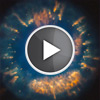CXC Home | Search | Help | Image Use Policy | Latest Images | Privacy | Accessibility | Glossary | Q&A
Tour of NGC 2392
MP4
Stars like the Sun can become remarkably photogenic at the end of their lives. A good example is NGC 2392, which is located about 4,200 light years from Earth.
NGC 2392 is what astronomers call a planetary nebula. This name, however, is deceiving because planetary nebulas actually have nothing to do with planets. The term is simply a historic relic since these objects looked like planetary disks to astronomers in earlier times looking through small optical telescopes. Instead, planetary nebulas form when a Sun-like star uses up all of the hydrogen in its core, which our Sun will in about 5 billion years from now.
When this happens, the star begins to cool and expand, increasing its radius by tens to hundreds of times its original size. Eventually, the outer layers of the star are swept away by a slow and thick wind, leaving behind a hot core. This hot core has a surface temperature of about 50,000 degrees Celsius, and is ejecting its outer layers in a fast wind traveling 6 million kilometers per hour.
The radiation from the hot star and the interaction of its fast wind with the slower wind creates the complex and filamentary shell of a planetary nebula. Eventually the central star will collapse to form a white dwarf star.
X-ray data from NASA's Chandra X-ray Observatory show the location of million-degree gas near the center of NGC 2392. Data from the Hubble Space Telescope reveal the intricate pattern of the outer layers of the star that have been ejected. Taken together, these data from today's space-based telescopes provide us with spectacular views of planetary nebulas that our scientific ancestors — those that thought these objects were associated with planets — probably could never have imagined.
[Runtime: 02:17]
MP4
- High Res (41 MB)
Stars like the Sun can become remarkably photogenic at the end of their lives. A good example is NGC 2392, which is located about 4,200 light years from Earth.
NGC 2392 is what astronomers call a planetary nebula. This name, however, is deceiving because planetary nebulas actually have nothing to do with planets. The term is simply a historic relic since these objects looked like planetary disks to astronomers in earlier times looking through small optical telescopes. Instead, planetary nebulas form when a Sun-like star uses up all of the hydrogen in its core, which our Sun will in about 5 billion years from now.
When this happens, the star begins to cool and expand, increasing its radius by tens to hundreds of times its original size. Eventually, the outer layers of the star are swept away by a slow and thick wind, leaving behind a hot core. This hot core has a surface temperature of about 50,000 degrees Celsius, and is ejecting its outer layers in a fast wind traveling 6 million kilometers per hour.
The radiation from the hot star and the interaction of its fast wind with the slower wind creates the complex and filamentary shell of a planetary nebula. Eventually the central star will collapse to form a white dwarf star.
X-ray data from NASA's Chandra X-ray Observatory show the location of million-degree gas near the center of NGC 2392. Data from the Hubble Space Telescope reveal the intricate pattern of the outer layers of the star that have been ejected. Taken together, these data from today's space-based telescopes provide us with spectacular views of planetary nebulas that our scientific ancestors — those that thought these objects were associated with planets — probably could never have imagined.
[Runtime: 02:17]
(Credit: NASA/CXC/J. DePasquale)
Circus in the Sky
Quicktime MPEG With closed-captions (at YouTube)
Before the telescope was invented in the 17th century, people thought that the Earth was the center of the Universe. They thought the Sun, the planets and all the stars revolved around us! It was only when we had the technology to peer deeper into space that we realised that not only does the Earth move around the Sun, but the Sun moves around the center of our galaxy, the Milky Way!
In the last 100 years, telescopes have been advancing at an unbelievable rate. Now we have huge radio telescopes that stretch over 50 kilometers, and we even have telescopes that have been launched into space. With these powerful instruments, we can reveal the secret wonders of the Universe that our ancestors never dreamed of!
Take this picture, for example, it shows a planetary nebula, which is the remains of a star that is blowing itself apart. This one is called the "Clownface Nebula", can you see why? It looks like a clowns head, complete with a crazy hairstyle and a big, shiny nose at the center.
This object was first spotted in 1757, but today we are still discovering new details about it. Shown in purple is gas at a temperature over a million degrees. The red, green and blue pattern shows the ejected outer layers of the exploded star. Much more recently, astronomers realized that a very hot pair of stars may live at the center of this gassy cloud, and they are orbiting each other!
[Runtime: 02:17]
Quicktime MPEG With closed-captions (at YouTube)
Before the telescope was invented in the 17th century, people thought that the Earth was the center of the Universe. They thought the Sun, the planets and all the stars revolved around us! It was only when we had the technology to peer deeper into space that we realised that not only does the Earth move around the Sun, but the Sun moves around the center of our galaxy, the Milky Way!
In the last 100 years, telescopes have been advancing at an unbelievable rate. Now we have huge radio telescopes that stretch over 50 kilometers, and we even have telescopes that have been launched into space. With these powerful instruments, we can reveal the secret wonders of the Universe that our ancestors never dreamed of!
Take this picture, for example, it shows a planetary nebula, which is the remains of a star that is blowing itself apart. This one is called the "Clownface Nebula", can you see why? It looks like a clowns head, complete with a crazy hairstyle and a big, shiny nose at the center.
This object was first spotted in 1757, but today we are still discovering new details about it. Shown in purple is gas at a temperature over a million degrees. The red, green and blue pattern shows the ejected outer layers of the exploded star. Much more recently, astronomers realized that a very hot pair of stars may live at the center of this gassy cloud, and they are orbiting each other!
[Runtime: 02:17]
(Credit: NASA/CXC/April Jubett)
Return to NGC 2392 (July 11, 2013)




